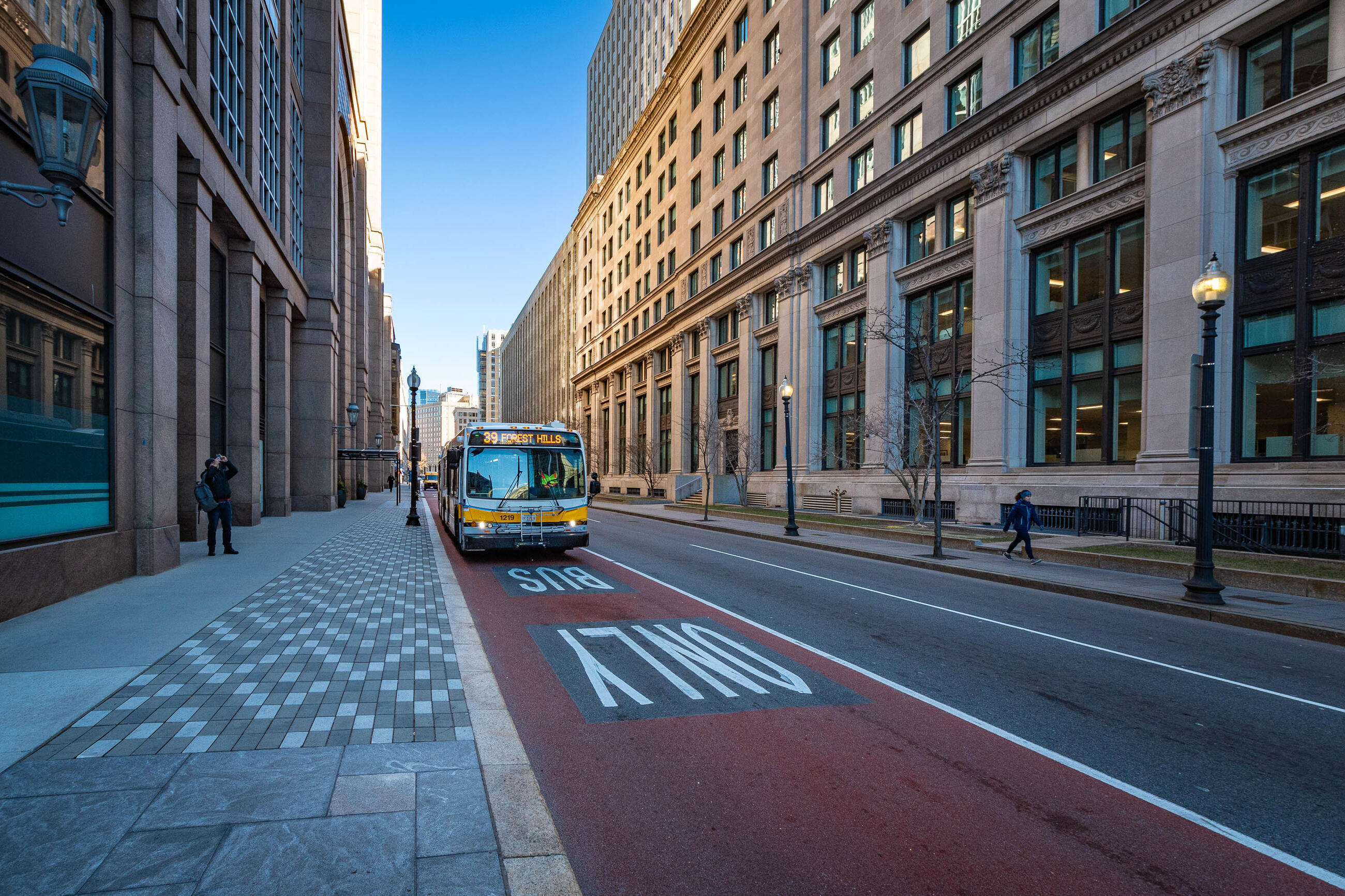Better Bus Project

We’re improving our bus system to deliver better service in the Greater Boston area. Buses carry 40% of our ridership, with nearly 300,000 passenger trips every weekday. Our improvement plans include increased service, dedicated bus lanes, and modernized facilities.
The Better Bus Project has four key goals:
- The bus is an easy first choice for more riders.
- Buses go when and where people need them.
- Riding the bus is a reliable experience.
- Bus stops are comfortable, accessible, and safe.
To learn more, jump to the relevant section below:
Better Bus Initiatives
We’re partnering with departments across the MBTA, over 50 municipalities, and MassDOT to plan, invest in, and implement major improvements to of our bus system. This includes updating bus routes, enhancing bus stops, installing bus lanes and transit priority measures, electrifying the fleet of approximately 1,000 buses, modernizing maintenance facilities, and more.
You told us what needs to be improved, and we heard you. The following Better Bus initiatives address areas that emerged from community feedback:
- Bus service
- Transit priority infrastructure
- Bus stop enhancements
- Bus facilities and operations
- Community updates
Each initiative area is designed to address different areas of the bus system and tackle the projects that will transform our service. Learn more about these projects at the links below.
Bus Service
We’re transforming our bus network with updated routes, more frequent service, and better transfer connections.
| Project | Status | ||
|---|---|---|---|
| Project | Bus Network Redesign, Phase 1 | Status | Planning |
| Project | Early Morning and Late Night Bus Service | Status | Completed (2020) |
| Project | Bus Route Changes | Status | Completed (December 2019) |
| Project | Bus Route Changes | Status | Completed (September 2019) |
Transit Priority Infrastructure
We’re partnering with municipalities to redesign key streets in Greater Boston to help buses move faster and more reliably across our region.
| Project | Status | ||
|---|---|---|---|
| Project | Transit Priority Strategy | Status | In progress |
| Project | Transit Priority Projects | Status | In progress |
| Project | Blue Hill Avenue | Status | In progress |
| Project | Columbus/Tremont, Phase 2 | Status | In progress |
| Project | Columbus Avenue Bus Lanes, Phase 1 | Status | Completed (2021) |
Bus Stop Enhancements
We’re improving bus stops across the network to make them more accessible, safe, and comfortable for riders.
| Project | Status | ||
|---|---|---|---|
| Project | Bus Stop E-Ink Signs | Status | In progress |
| Project | Bus Stop Accessibility Improvements | Status | In progress |
Bus Facilities and Operations
From electrifying our bus fleet to upgrading our maintenance facilities, we’re investing in a modern and sustainable system that will keep our riders moving.
| Project | Status | ||
|---|---|---|---|
| Project | Bus Facility Modernization | Status | In progress |
| Project | Bus Electrification | Status | In progress |
Community Updates
Feedback from riders is crucial to improving the bus system. We received over 20,000 community comments during the Bus Network Redesign process and continue to host in-person and virtual activities as we roll out service changes.
Better Bus Updates Archive
Bus Transformation Update (January 25, 2021)
Bus Network Redesign Update: High Priority Corridors (November 23, 2020)
Bus Network Redesign Update: Early Action Service Principles (February 24, 2020)
Bus Transformation (January 27, 2020)
Bus Network Redesign demonstration projects update (December 9. 2019)
Better Bus Project update/on time performance plan (December 9. 2019)
Bus Network Redesign demonstration projects update (October 21, 2019)
Better Bus Project near-term changes and multi-year investment strategy (September 23, 2019)
Bus Network Redesign metrics update (September 23, 2019)
Bus Network Redesign policy and process update (July 23, 2019)
Updates on near-term changes and bus priority infrastructure (June 24, 2019)
Memo: Title VI equity analysis (May 6, 2019)
Equity analysis and key performance metrics (May 6, 2019)
Summary of deeper analysis of proposals (April 8, 2019)
Bus network redesign update (March 25, 2019)
Review of preliminary feedback (March 25, 2019)
Proposed investment strategy (February 25, 2019)
Public outreach and near-term proposals (February 4, 2019)
Work plan including the timeline release of near-term proposals (January 14, 2019)
Review of work plan (December 10, 2018)
Bus service network overview and redesign (September 24, 2018)
Bus network strategy and service improvements (July 16, 2018)
Goals, standards, data, and outreach (June 25, 2018)
Memo: Data analytics, technical tools, outreach, and partnerships (April 4, 2018)
Building a Better T
As part of our $9.6 billion, 5-year capital investment plan, we're renovating stations, modernizing fare collection systems, upgrading services for our buses, subways, and ferries, and improving the accessibility of the entire system.
Past Events
Contact Us
For all questions and comments related to Better Bus Project, please contact us at betterbusproject@mbta.com.
Get project updates and news delivered to your inbox:
Better Bus Project Updates
Related Projects
Building a Better T
As part of our $9.6 billion, 5-year capital investment plan, we're renovating stations, modernizing fare collection systems, upgrading services for our buses, subways, and ferries, and improving the accessibility of the entire system.


